World Dream Bank
home -
add a dream -
newest -
art gallery -
sampler -
dreams by
title,
subject,
author,
date,
places,
names
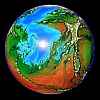
 SERRANA
SERRANA
by Chris Wayan, 2004-6
for Ursula K. Le Guin, Peter Kropotkin, and Emma Goldman
down to map and regional tours - Creatures and People - Culture - Evolution - Gazetteer - How I Built Serrana -
more worlds? Planetocopia!
INTRODUCTION
Serrana's a tribute and an experiment. The tribute's easy to explain. I just reread Ursula Le Guin's classic fable on anarchism, THE DISPOSSESSED. Purely aside from its political and literary merit (both of which have held up quite well since the 1970s--the book made me furious we've settled for so little political progress)... I was also intrigued by Anarres as a world--a planetary type that must be common in the cosmos, but neglected by most exobiologists and science fiction writers.
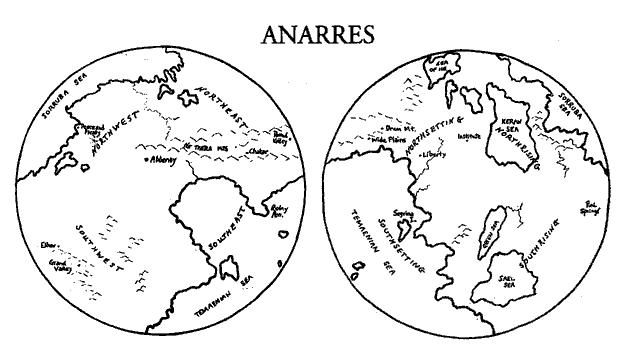
Picture a hybrid of Mars and Earth--a small world with thin air, cool and dry. Dusty desert plains girdle the globe; shallow seas merely dot the land. Sparse plants in the rainier zones, and seas teeming with fish, but the harsh continental climate's slowed land evolution: a few worms are the only land animals. Geologically, it's old and tired--few mountains and those worn down to rounded hills. No active volcanoes (though there are some quakes). Anarres was clearly based on our view of Mars at the time. A bit warmer, a bit wetter, livable--but just barely.
The book's only map is a sketch without a scale. But the text does mention Red Springs and Abbenay are 2500 miles apart; that'd make the planet no larger than Mercury, maybe even as small as Luna! Yet its gravity suggests a much bigger world, at least Martian, more likely even bigger--our hero gets into serious troubles when he goes offworld, but extra weight gives him barely a twinge. Nor could a moon with mere lunar gravity retain so much air and water.
There are other scale-discrepancies between text and map making it clear Anarres is a political fable, not a physical ecology. But ecology is politics! Pushing a world into the background is exactly how people kill it. So... I've rebuilt Anarres in the light of modern planetology. The coastlines match, the lands and seas are recognizably Anarresti, but this new version is larger (diameter: 6000 miles, midway between Earth and Mars), more mountainous and geologically active (as Mars turned out to be), warmer (more volcanic CO2 to trap heat), and with a more evolved flora and fauna--intelligent fauna with their own version of anarchism. No need for a transplanted human civilization from some big-brother world, as in the book. It's Anarres grown up--revised, reborn and renamed:
Welcome to Serrana.
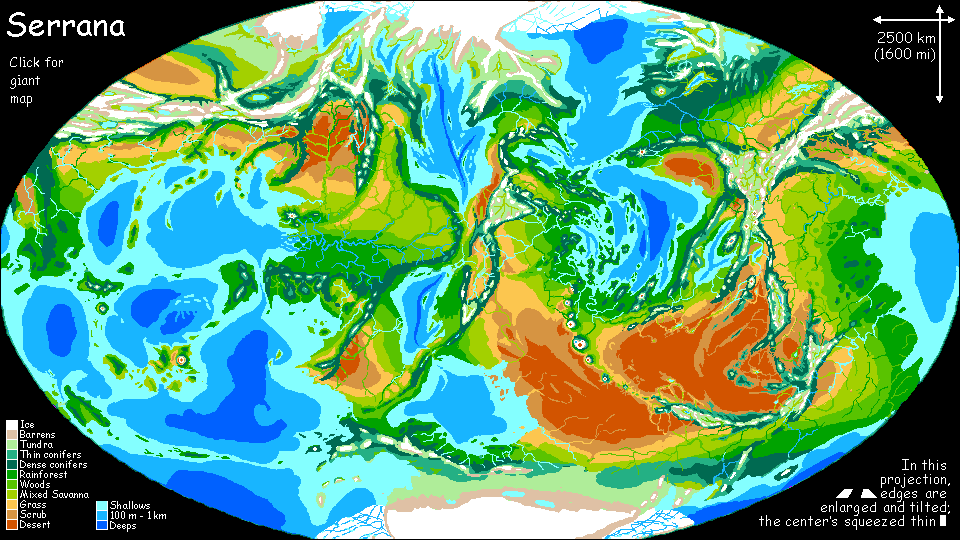
- Sun: a class K star, smaller, yellower and cooler than Sol--and much commoner! Most exobiologists focus on sunlike stars. They assume the viable zone around small suns will be too close--solar tides would drag at any planets until they're locked facing the sun: burning dayside, freezing nightside. But this overlooks four spin factors:
- Dumb luck. How big's a world, and what bodies formed it? What hit it later, at what angles? Jupiter and Saturn, too big to easily knock around, spin very fast indeed. They suggest most planets start fast but lose random amounts of spin to impacts. Unlucky worlds like Venus get whacked and slowed, or fully tidelocked. But some worlds get lucky.
- Deep time. When Luna was young and close, its tidal drag was huge, far greater than the steady solar tides proposed for Serrana. Yet Earth spins as fast as tideless Mars, despite eras of strong tidal drag! And Mercury, despite stronger solar tides, spins faster than Venus. Our sample's still too small to conclude that solar tides lock all sunhugging planets. Some, yes--but all?
- Greenhouse effects. Thick air and high CO2 can warm a world enough for liquid water and life--far enough out from its sun to make solar tidelocking unlikely. "Tepid Jupiters" are known to be common; Lyr is a model of a large world orbiting outside the liquid water zone, yet covered with oceans--and life. Serrana is dry, but rich in CO2, keeping it warm enough for life.
- Not all sun-hugging worlds look first to their sun. Don't forget moons. Their biggest tidal influence is their planet, not the sun, so they end up facing their primary--and spinning relative to their sun, even if it's close. A giant acts as spin insurance! Pegasia is a model of a tidelocked moon with a quite livable 48-hour day.
Since big suns like ours are rare, even if only a few smaller stars have living worlds, such biospheres probably outnumber the Earths out there.
- Orbit = elliptical, from about 0.65 to 0.8 AU. At its furthest, the sun looks the size of Sol, though redder and cooler; at its closest, much larger than Sol, and a bit brighter. Why elliptical? Well, eccentric planets are also common yet written off as unfriendly to life. But are they?
-
Mass = 1/3 Earth's, triple Mars's. (Yeah, Mars really is just 11% of Earth's mass! Just a pebble with good press!) Why make Serrana so small? 1: Most stars are dwarf stars; they're likely to have dwarf planets. 2: The average star (and solar system) is also 25% poorer in heavy elements than Sol. So even large stars may often have rocky planets more like Mars than Earth. 3: A lot of stars have "hot Jupiters" in tight orbits. It's thought these giants spiral in, swallowing smaller planets in their way, or flinging them out of the solar system. But the most recent simulations suggest quite a lot of that flung material ends up in the habitable zone, though often in more eccentric orbits than before. A demolition derby ensues, delaying planet-formation; but in the end rocky planets often do form, if smaller, drier and more eccentric than Earth. I'm out to show "small is beautiful"--show how little rock and water it takes to make a healthy biosphere.
- Density = 4.5 gm/ml, between Earth's 5.5 and Mars's 4. Solar tides keep the iron core hot and liquid, so there's a significant magnetic field.
- Diameter = about 6000 miles / 9600 km, around 3/4 Earth's diameter. Nearly 50% larger than Mars's! Circumference is nearly 19,000 mi /30,000 km. Ten degrees is a bit over 500 mi / 800 km.
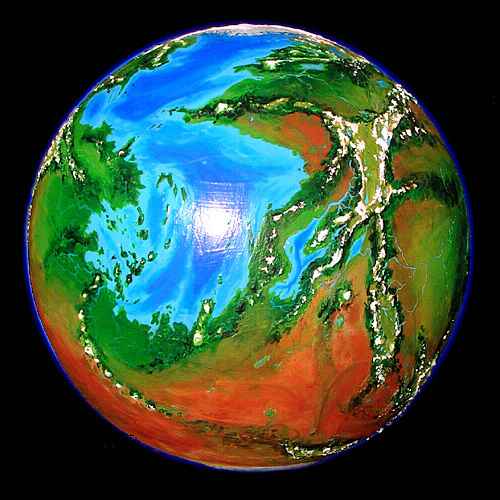
- Surface area = just over half Earth's--about 110 million square miles / 265 million sq km.
- Land area = same as Earth's! 60 million sq mi / 150 million sq km.
- Gravity = 0.65 G, midway between Earth's (1.00) and Mars's (0.38).
- Satellites = Three moonlets 1-200 km across--pleasant night lights, but their tidal pull is insignificant. Let's throw in a small ring, too--a dim one, since Serrana's too warm for ice rings. Rocks. A dark bronze arch on clear nights.
- Internal heat and volcanic potential = Earthlike and then some. No tidal stress from a large moon, but Serrana's faster rotation and larger solar tides more than make up for it, keeping the core and mantle quite hot. This differs from Le Guin's Anarres; when she wrote in the 1970s, the size of a world (and thus how easily radioactive heating escaped) was believed to determine vulcanism and tectonic activity; tidal stress wasn't yet appreciated.
- Day = 16 Earth hours. Serrana has thin air and continental climates, but the short day evens the daily temperature swings a lot. The fast spin drives strong currents and winds, too. A subtler third effect: the fast solar tides heat up Serrana's mantle, stimulating tectonics--and the extra volcanic CO2 warms the climate.
- Total annual insolation = Earthlike. But the eccentric orbit creates a strong annual fluctuation--a short hot worldwide summer, then a long cool worldwide winter (the outer half of an elliptical orbit is slower--takes up more of the year).
- Axial tilt = under 10%, possibly under 5% like Venus. Why? Not for any scientific reason--I just had this round light fixture suitable for sculpting into a globe, and I put the south pole where this real, honest-to-God pole stuck out the bottom, and so the north pole went right at the top--like a map, not a real, tilted world. Only AFTER I'd sculpted it all did I realize there was no way to unscrew it now to tilt the axis. How embarrassing! Hence the elliptical orbit--I didn't want a totally seasonless world!
- Radiation levels = Below Earth's. Thin air allows more through, but the cooler sun produces much less. Surface radiation levels were once believed crucial to mutation, and thus to evolution itself, so cool stars might evolve complex life late or never. Now that it's clear environmental stresses push evolution more than the mutation rate, radiation seem less crucial, so I haven't tried to calculate exact levels.
- Year = about 6 Earth months
- Seasons = planet-wide, not hemispheric as on Earth, caused more by the elliptical orbit than axial tilt. This means the equatorial belt isn't tropical in the seasonless year-round Terran sense. In global winter, "rainforests" are warm to mild with light rains; in the summer, hot and torrential, though none match our Amazon.
- Water = 7-8% of Earth's, and a quarter of that's locked up as ice. Why so little? Not just as a tribute to Le Guin's dry Anarres, but because dry worlds are assumed to be biologically poor. But are they?
- Seas = 45% of surface area, in six shallow, separate seas. The Eamet Ocean averages less than a kilometer deep, and the smaller seas are shallower still. I've measured altitudes from the Eamet's sea level; the northern Aburros and Narek Seas lie about 100 meters higher, the Leas and Niirg Seas around 100 lower, due to evaporation in their hot dry basins.
- Relief = rugged, due to low gravity and active tectonics. Tallest peak is over 12 km above sea level (Earth, 8.85); the deepest ocean trench is 3.2 km, but most aren't even 2 (Earth, 11). Common features:
- long winding ridges, often with rift-valleys down the middle, like our mid-sea ridges or Venus's chasmas. But some widen into plateaus; Earth's nearest equivalents are Iceland and the Altiplano, but Serrana's planos are much larger.
- high, volcano-studded Andean ranges where plates collide or subduct.
- huge, near-Martian shield volcanoes over hot spots.
- Tectonic plates = patchy. Relatively Earthlike around the lubricating seas, but the large dry zones tend to grow Martian shield volcanoes and tholi, as well as Venusian chasmas and coronas.
- Continents = none in our sense! The land, covering 55% of the surface, is continuous, and it's basaltic, like sea-floors on Earth. High regions of lighter rock like Earth's continents are quite limited--a few percent of the surface, as on Venus. They form little Tibets called planos, mostly alpine or tundra.
- Atmosphere = nitrogen 75%, oxygen 21%, neon and argon nearly 4%. Of course, it's no coincidence the air is Earthlike--that's a result of life. I'm not pushing a total Gaia hypothesis in which life deliberately generates an optimal envelope for itself (Earth's isn't optimal, after all).
- Air pressure at sea level = about 500 millibars, or 2/3 Earth's pressure--what we breathe at about 2500 meters up. Due to lower gravity, it drops off slower; the air's thin but breathable up to 5-6000 meters (16-20,000 ft), though only Tibetan and Andean tourists (and native Serranians, of course) would be comfortable above 3000. If you doubt Serrana's low gravity could hang on to even this much air, I refer you to Venus and Titan. Don't obsess on Mars!
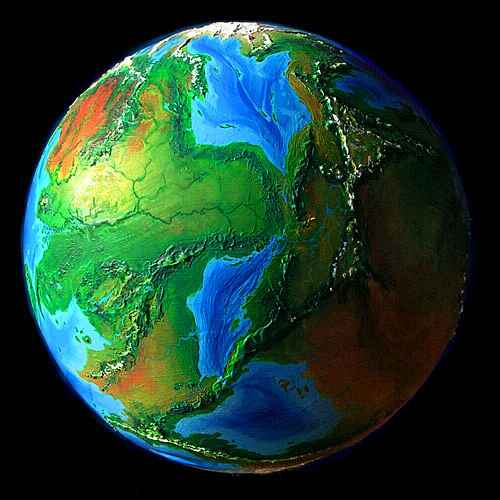
- Sky color = variable. Deep indigo in the planos and mountains, turquoise to lavender (depending on dust) over most forests and seas, pale greens and whites over savannas, and gold over most deserts--but salmon as Mars, in the heart of the Tsud. Sunsets tend to be bloody extravaganzas worldwide, as dust levels are high. Thin haze often shrouds the horizon, and at night, only the ring, the moons and brightest stars shine through.
- Cloud cover = Dense regionally, but on average, barely half Earth's. So much of Serrana is dry!
- Albedo (reflectivity) = unexpectedly Earthlike. The deserts reflect more sun than Earth's more extensive forests and seas. But the cloud cover is far less. These factors roughly cancel out--in fact, Serrana's albedo is slightly lower than Earth's, warming Serrana a few degrees more than you'd expect for its CO2 levels.
- CO2 = 900 ppm! Serrana's thin air makes this comparable to about 600 ppm on Earth. That much still creates a greenhouse effect much stronger than Earth's. With its thinner air and sunlight, Serrana needs it! Volcanic CO2 output is above Earth's average, and the flora's inherently thinner than Earth's, so it absorbs less CO2; the seas are smaller, so their CO2 sponge is limited too. The main feedback loop on land: Eruptions belch CO2, the climate warms, rain increases, rocks weather faster, forests and prairies flourish further inland, locking up carbon, and melting ice swells the shallow seas... all sucking up CO2 again. Low CO2 chills the tropics and builds ice caps, until storms only hug the shrunken seas; inland basins dry and die back. With less living vegetation to absorb CO2, levels rise again. On Earth, the loop's a bit different: during ice ages, forests do die and deserts increase, but dust and glacial silt fertilizes seas that are nutrient-starved in warmer eras. Basically, while land plants die back, releasing CO2, the seas bloom, sucking up CO2. Life's net effect is small, so on Earth inanimate factors dominate the CO2 feedback loop: shifting currents, volcanoes, and the weathering of fresh rock in new mountain ranges. But on Serrana, the seas are always dusty and fertile, so ice-age dust doesn't change much. No plankton boom, no CO2 sponge! The die-back on land is unopposed, releasing CO2--and the ice melts.
- Temperature = Earthlike; about 5 degrees warmer, on a global average. High CO2 and low cloud cover would make it hotter still, but thin air saps the greenhouse effect. This global average means very little, though: away from the seas, summers are hot and winters cold. (This warmth distinguishes Serrana from Le Guin's chilly Anarres; she emphasized the effect of thin air, but we know more now about the crucial role of trace gasses like CO2; and tidal effects on both Anarres and Serrana guarantee lots of volcanic CO2.)
- Air loss over time = substantial. In Serrana's early days, when its sun was dimmer (most stars slowly brighten with age) the planet would've been a global snowball, EXCEPT... small worlds lose more air than Earth-sized ones, and back then Serrana's atmosphere was at least twice its current pressure--far more efficient at heat-trapping. Chronic air loss sounds fatal for a biosphere, but given most suns' tendency to heat up as they age, leaky little worlds really have a built-in safety valve, while big worlds risk a Venusian meltdown. In fact, it could happen here.
- Polar caps = 4% of surface, compared to 3% on Earth at present (soon to be less!). The South Pole has 3/4 of the ice. The North Pole has only two Greenlandish peninsulas with thick caps, linked by thin sea ice. Tundra's more extensive than Earth's, too--6-8% of the surface! Why more ice, if Serrana's warmer and drier than Earth? Simple: there's land under both poles, so thick icecaps can grow. Antarctica and Greenland are fenced in by deep sea. Paradoxical though it sounds, Serrana's warmer than Earth AND in a mild, permanent ice age caused by its own geography.
- Habitats = as diverse as Earth's, and similar, though in different proportions. The largest by area are desert, then veldt, then tundra, then mixed savanna (scattered trees, groves, or riverine strips in dry grassland), tropical forests, mountain and temperate forests, and cool, grassy alpine planos. The shallow seas have far more extensive coral reefs than Earth. Even the deep seas are plankton-rich: fertilized by dust blown off the deserts.
- Biomass = 69% of Earth's. Average density: 123% of Earth's!
- Land = only 60% of Earth mass and density. All those deserts...
- Sea = twice as dense as our seas, but only 72% as much total biomass. Rich but tiny...
- Biodiversity = more than Earth. The isolated seas evolved along different paths, so the pioneer species creeping out of those seas were wildly diverse. Large invertebrates like hexapedal squid and insectoid quadrupeds share the land with centauroid mammals, griffinlike pseudobirds and bipedal feathered dinosaurs... see Evolution on Serrana.
- Intelligent species = at least six in various niches--fructivorous tree-squid in the rainforests, centauroid grazers and land-octopi on the veldts, a big-lunged llamoid mountain folk, a dust-adapted desert saurian, a mammoth lichen-eating tundra-crab. See Peoples of Serrana.
- Civilization = one! Rather than rival nations/races, Serrana's species evolved one cooperative society. Not quite Odonian anarchism, but Kropotkin would approve. Serrana illustrates his anarchist theory based on cooperation in nature, just as Anarres showcased Emma Goldman's more politically-based anarchism. See Competition and cooperation
- Nomenclature and pronunciation: see Gazetteer.
The experimental side of Serrana may be obvious by now. It's a challenge to exobiologists like Peter Ward Douglas ("Rare Earth") who claim complex life will only evolve on the few planets almost exactly like ours. Serrana has a multitude of key factors wrong--wrong sun, wrong neighbors (a hot Jupiter), wrong distance, wrong orbit, wrong tilt, wrong size, wrong spin, wrong moons, wrong geology, wrong water content... you can't get much wronger. According to "Rare Earth", worlds like Serrana (let alone Anarres) are hopeless little losers fit only for bacteria.
Tell that to the locals!
Click any region of the map below for photos and a description of the land, climate, flora and fauna (if any! Serrana does work, but not quite as a biosphere--it's a bio-swiss cheese, as patchy as an old man's hair.)
 TOUR SERRANA! Click a region for a detailed ground-level tour:
Aburros Sea -
Woble Range -
Yanneba Basin and Plano -
Mosnoll and Eronit Basins -
The Tsud Desert -
Eamet Ocean and South Pole -
Leas, Niirg, and Narek: The Lesser Seas -
The Rakach Plateau and the Northlands
TOUR SERRANA! Click a region for a detailed ground-level tour:
Aburros Sea -
Woble Range -
Yanneba Basin and Plano -
Mosnoll and Eronit Basins -
The Tsud Desert -
Eamet Ocean and South Pole -
Leas, Niirg, and Narek: The Lesser Seas -
The Rakach Plateau and the Northlands
Serrana's homepage -
Peoples of Serrana -
Culture -
Evolution -
Gazetteer -
How I Built Serrana
LISTS AND LINKS: more world-models: Planetocopia - dreams of other worlds - ecology - climate change - evolution - populations and eco-crashes - natural disasters - terraforming - orbital dreams - sculptures and 3D art - centaurs - fox people - flying - molluscan people - elephant people - dinosaur people - anarchy - utopias -
World Dream Bank homepage - Art gallery - New stuff - Introductory sampler, best dreams, best art - On dreamwork - Books
Indexes: Subject - Author - Date - Names - Places - Art media/styles
Titles: A - B - C - D - E - F - G - H - IJ - KL - M - NO - PQ - R - Sa-Sk - Sl-Sz - T - UV - WXYZ
Email: wdreamb@yahoo.com - Catalog of art, books, CDs - Behind the Curtain: FAQs, bio, site map - Kindred sites
SERRANA
SERRANA